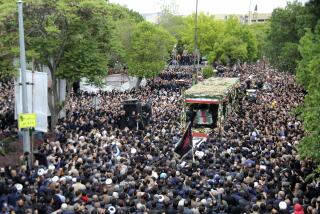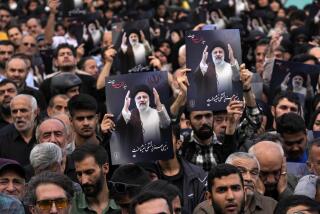Iran Officials Cite Possible Radio Lapse
- Share via
BANDAR ABBAS, Iran — Officials at this Persian Gulf airport and military base Wednesday defended the pilot of the Iran Air jetliner shot down by a U.S. Navy cruiser but conceded that he might not have been monitoring the radio frequency used by American warships in the gulf.
At the same time, these officials insisted that the Airbus A-300 could not have been descending toward the cruiser Vincennes in a threatening manner, as the Navy has claimed. U.S. officials have said the ship’s skipper believed that the craft was a hostile Iranian F-14 fighter and ordered it shot down Sunday over the Strait of Hormuz. All 290 passengers and crew members were killed.
Two senior Iran Air pilots, both familiar with the route of the ill-fated Flight 655 from Bandar Abbas to Dubai in the United Arab Emirates, said 655’s pilot, whom they identified as Capt. Mohsen Rezaian, might not have switched his emergency-frequency radio to the channel used by U.S. warships in the region.
“There are many other things to be doing in the cockpit at that stage of the flight,” said one, Capt. Reza Bahrami. “He had two other frequencies to monitor with ground controllers, and he may simply not have been tuned in to the American warnings.”
He added, “After all, he was still over Iranian flying space and not necessarily listening in to the American warships.” A 10-mile-wide airway is generally recognized for civilian traffic across the strait.
On Monday, a former Iran Air pilot living in California had said he believed that a pilot named Amir Razvani had been in command of Flight 655 on Sunday.
Total of 12 Warnings
Radiomen on the Vincennes and the nearby U.S. guided-missile frigate John H. Sides have said they sent a total of 12 warnings to the suspect aircraft, demanding that it identify itself and ordering it to change course.
Bahrami and his colleague, Capt. Ali Mahdaviani, commented as part of a series of remarks made here and in Tehran for the first time on behalf of Capt. Rezaian’s actions. The remarks came against a backdrop of grief and anger in Iran, still simmering over the incident in the strait just off this dusty, palm-lined port city.
Hashemi Rafsanjani, the powerful Speaker of Iran’s Parliament and acting commander in chief of the armed forces, was scheduled to lead commemorative ceremonies for the dead in Bandar Abbas on Wednesday. In Tehran, about 100 Iran Air employees mourned their colleagues Wednesday, and a funeral procession for all victims is planned there today.
200 Bodies Recovered
About 200 bodies pulled from the sea have been taken to a huge room of a refrigerated storage building in Bandar Abbas and placed in wooden coffins, some draped with black mourning flags and others with the green, white and red flag of Iran. About 150 have been identified, 50 of them children, officials said.
The Iranians also have displayed some of the recovered wreckage of Flight 655 on the parade ground of the naval base here, headquarters of Iranian fleet.
“This is what President Reagan’s human rights means,” said a bitter Iraj Shani, local manager for Iran Air. “Reagan goes to Moscow to talk about human rights, but this is the reality of the U.S. position toward Iran.”
The two Iran Air pilots, joined by Iranian air force officers and air controllers in Bandar Abbas, said the plane was only seven minutes into its regularly scheduled half-hour flight when it was struck by at least one missile fired by the Vincennes. Thus, they said, it still should have been climbing after takeoff.
‘Americans Are Wrong’
“These Americans are simply wrong when they say he was off course and descending,” declared Mahdaviani, who like Bahrami had taught Rezaian and had supervised his training on the Airbus. Both Mahdaviani and Bahrami were trained in the United States.
The captains said Rezaian had been flying for two years and had accrued about 1,500 hours flight time on the plane.
“He was a very cautious man and would not have taken any foolish chances,” Mahdaviani said.
But the Bandar Abbas air controllers said that Rezaian might not have turned on his transponder, a transmitter that responds to electronic questioning by radar operators by emitting a signal that identifies the aircraft.
Possibly Unaware
They also indicated that Rezaian may have not been fully informed of the hostile action earlier Sunday between the Vincennes and three small Iranian speedboats that had engaged the ship in surface fire.
However, Mahdaviani and Bahrami maintained that switching on the transponder was one of the first items on a pilot’s check list.
As to why the accident happened, Mahdaviani said of the Vincennes’ skipper, Capt. Will C. Rogers III, “He must have been a very nervous commander--and very, very irresponsible.”
More to Read
Sign up for Essential California
The most important California stories and recommendations in your inbox every morning.
You may occasionally receive promotional content from the Los Angeles Times.










